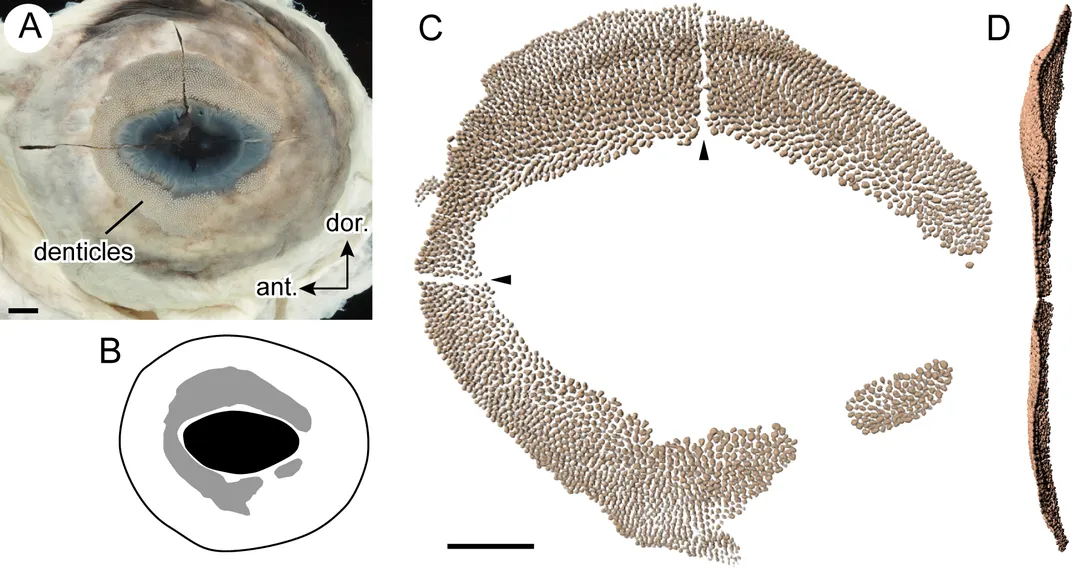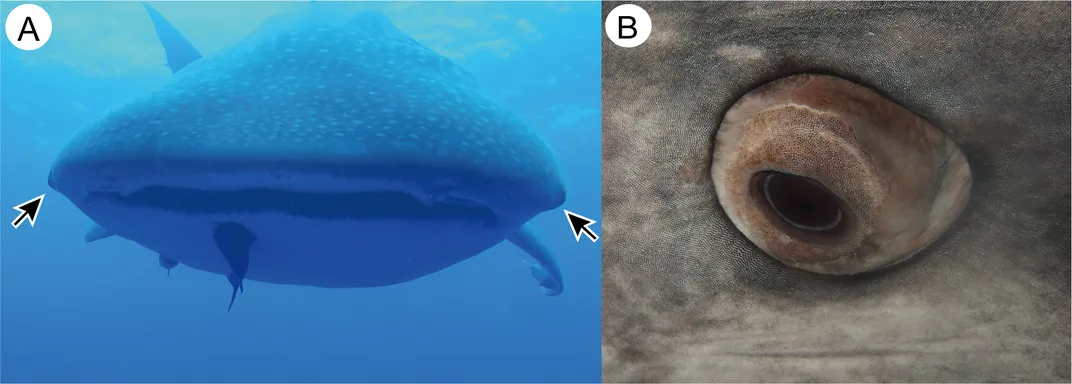Whale Sharks Have Tiny Teeth on Their Eyeballs
The ‘dermal denticles’ probably help protect the eyes of these gentle giants, scientists say
/https://tf-cmsv2-smithsonianmag-media.s3.amazonaws.com/filer/99/14/99143e85-ae70-4c34-9748-cfe3ab7dcfae/whale_shark_with_a_tourist_in_australia_2012.jpg)
Whale sharks are known as gentle, bespeckled giants that swim in tropical seas and scoop up plankton with their cavernous mouths. According to new research, they also have a sharp eye—literally: their eyes are covered in tiny teeth.
The “dermal denticles” are modified, tiny teeth that cover the whale shark’s eyeballs, according to marine biologists from Japan’s Okinawa Churashima Research Center, who published their discovery in PLOS One Tuesday.
Whale sharks and other shark species have dermal denticles that cover their bodies and act like scales, according to the Smithsonian Institution’s Ocean Portal. The tiny, V-shaped pieces decrease drag and turbulence as sharks glide through the water, which helps them swim faster. They can also provide protection against other sharks who might bite them, reports Bob Yirka for Phys.org.
Eyeball teeth, however, probably serve as protective armor against the elements, reports George Dvorsky for Gizmodo. Whale sharks’ eyes have no eyelids and poke out on either side of their heads, which makes them vulnerable to exposure.
“Considering that these tissues are exposed and that whale sharks lack eyelids; the eye surface is less protected from mechanical damage than other regions of the body that are covered with mineralized dermal denticles,” the study authors write. “Thus, the covering of the eye surface with denticles in the whale shark is probably useful in reducing the risk of mechanical damage to the eye surface.”
The team, led by marine biologist Taketeru Tomita of Japan's Okinawa Churashima Foundation Research Center, studied eyes from both living and dead sharks that had washed ashore. They found that just one whale shark eyeball could have more than 3,000 denticles, which are clustered around the iris.
Looking through a microscope, the researchers described the denticles as having an “oak-leaf” shape. Some of them even resemble human molars, reports Dvorsky.
The scientists also noted that whale sharks have the ability to partially retract their eyeballs into their skulls, reports Hannah Osbourne for Newsweek. Both protective mechanisms—retractability and the tiny teeth—suggest to the researchers that whale shark’s eyes might be more important to the fish’s survival than previously thought. Typically, scientists have assumed that the giants rely more on smell than sight to navigate their surroundings, in part because the whale sharks have relatively small eyes.
“However, the highly protected features of the whale shark eye, in contrast to the traditional view, seems to suggest the importance of vision in this species,” the authors write.
Whale sharks can grow up to 50 feet long, making them the world’s largest fish. As Theresa Machemer reported for Smithsonian magazine in April, researchers recently used radioactive dating techniques to learn that the giant creatures can live to at least 50 years old.
/https://tf-cmsv2-smithsonianmag-media.s3.amazonaws.com/accounts/headshot/nora.png)


/https://tf-cmsv2-smithsonianmag-media.s3.amazonaws.com/accounts/headshot/nora.png)